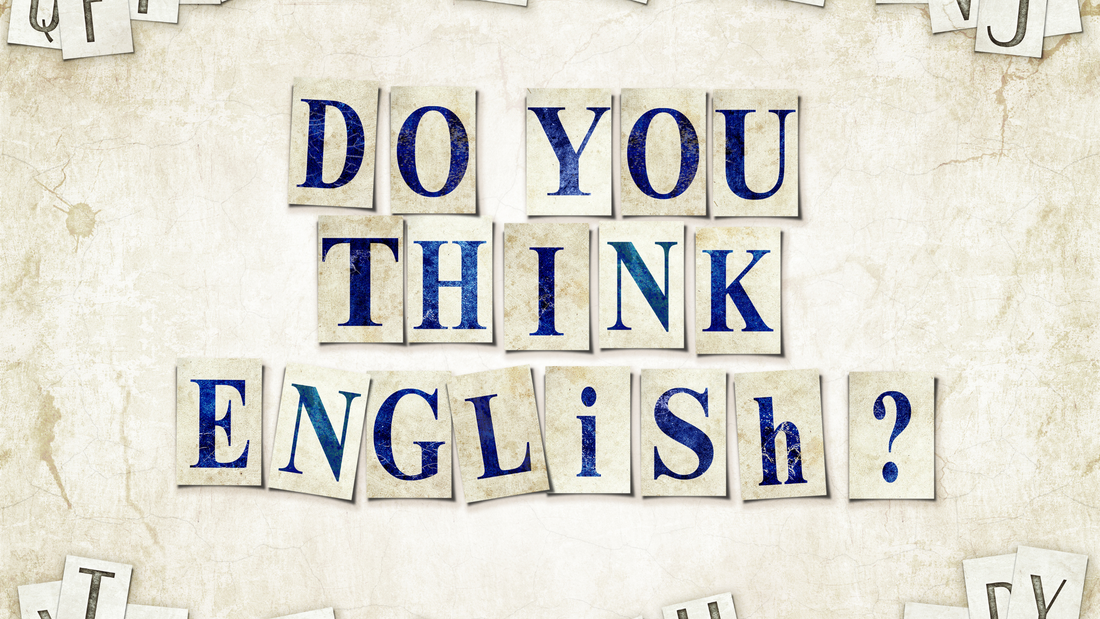
How to Think in English: 7 Strategies That Actually Work
Aubrey Bermudez-BadaguasHave you ever caught yourself translating every sentence from your native language into English before you speak? If so, you’re not alone. Almost every English learner has been there. You know the words, you know the grammar—but when it’s time to speak, your brain starts translating, hesitating, and second-guessing.
This is one of the biggest barriers to fluency: the constant need to “translate before speaking.”
Here’s the truth: to speak fluently, you have to learn to think in English. It sounds simple, but it’s a powerful shift. Once you start thinking in English—even in small ways—you’ll notice faster responses, better vocabulary recall, and more natural conversations.
Let’s look at why this matters and how you can start doing it—even if you're a beginner.
 1. Start with Single Words
1. Start with Single Words
If you’re new to this, don’t try to think in full sentences right away. Start small. When you look at something, try to name it in English—in your mind.
💬 Example:
See a “chair”? Say “chair.”
Walking outside? Think: “tree,” “sky,” “car,” “sun.”
You don’t need to build a full sentence like “I see a car on the road.” Just naming things is a great first step. It teaches your brain to switch languages without needing to translate.
✅ Tip: Set a goal to name 10 things around you in English each day.
 2. Use English for Everyday Decisions
2. Use English for Everyday Decisions
Try to think in English when you make small decisions.
💬 Example:
“I’m going to make coffee.”
“I need to charge my phone.”
“Let’s wear something warm—it’s cold today.”
These aren’t complicated thoughts. You already think them every day—now just try thinking them in English. The more you do this, the more natural it becomes.
✅ Bonus tip: Narrate your actions in your head. “Opening the fridge. Looking for milk. Oh, it’s empty!”
 3. Label Your Environment
3. Label Your Environment
This works especially well for visual learners. Put sticky notes on common items in your home—mirror, desk, fridge, light switch—with their English names.
Every time you see the object, say the word silently (or out loud!). This builds a direct link between the object and the English word—no translation needed.
💬 Example:
Stick a note on your mirror that says “mirror” or “Look at yourself and smile!” 😄
✅ Over time, your brain starts seeing the item and thinking in English automatically.
 4. Ask Yourself Simple Questions in English
4. Ask Yourself Simple Questions in English
Train your brain to process thoughts in English by asking yourself basic questions.
💬 Examples:
-
“What time is it?”
-
“What do I want to eat?”
-
“What’s the weather like?”
-
“What do I need to do today?”
Then, try to answer in English. The point isn’t to be perfect—it’s to practice thinking in the language without switching back and forth.
✅ Tip: Make this part of your morning or evening routine.
 5. Use Visual Thinking (Instead of Translating)
5. Use Visual Thinking (Instead of Translating)
This one is a game-changer: stop imagining your native language, and instead, link English words directly to images or feelings.
💬 For example:
Instead of translating the word “apple” from your native language, picture a red apple in your mind and think “apple.”
This bypasses translation and builds strong, fast word recall.
✅ Try flashcards with pictures (not translations). Apps like Anki or Quizlet can help with this.
 6. Practice Inner Dialogues in English
6. Practice Inner Dialogues in English
Have a little conversation with yourself—in your head.
💬 Example:
Imagine you’re meeting a friend. In your mind, say:
“Hi! How are you?”
“I’m doing well, thanks! What about you?”
You don’t need a partner for this. Just imagine everyday situations and “play them out” in English in your mind.
✅ This is great practice before real conversations. You’ll feel more prepared and less nervous.
 7. Think in English Before You Sleep
7. Think in English Before You Sleep
Here’s a gentle way to close your day: reflect on it in English.
💬 Example: “What did I do today?”
“I worked, cooked dinner, watched a movie…”
“What will I do tomorrow?”
It doesn’t have to be long or perfect. The goal is consistency. A few minutes of quiet thinking in English every night builds a powerful habit.
✅ Keep a journal by your bed and write one sentence a night in English. It reinforces your thinking and gives you something to review later.
 Final Thoughts: Think First, Speak Faster 💬⚡
Final Thoughts: Think First, Speak Faster 💬⚡
Learning to think in English won’t happen overnight—but it will happen with practice. And when it does, you’ll stop feeling “stuck” during conversations. Words will come faster. You’ll feel more natural. And most importantly—you’ll speak with confidence.
So start small. Think one word. One sentence. One thought at a time.
You don’t need to wait until you’re fluent to begin. In fact, thinking in English is how you become fluent.
I’m here cheering you on every step of the way.
With you on your journey,
Teacher Aubrey


5 comments
Thank you teacher Aubrey
Thanks!
Exlant way easy way 7 steps perfect way start English 👍👍
Thanks a lot I learn some ideas or ways to improve my English vocabulary..
Thanks a lot It help me, and gain some ideas..for learning English.